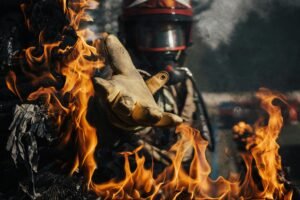Contents
ToggleFirefighting Tactics and Strategies: Ensuring Effective Fire Suppression
Firefighting is much more than simply putting out fires. It encompasses strategic responses designed to manage emergencies efficiently, prioritizing the safety of both civilians and firefighters. By mastering a range of tactics, firefighting teams can improve response times, minimize damage to property, and, most importantly, save lives. Below is a closer examination of the essential components and strategies that define effective firefighting operations.
1. Incident Command System (ICS)
The Incident Command System (ICS) is a structured framework for managing emergencies, ensuring coordination among multiple agencies and organizations. Key aspects of ICS include:
- Unified Command: A centralized command structure enables various departments to collaborate seamlessly, focusing on a shared objective.
- Defined Roles and Responsibilities: Clearly assigning tasks reduces confusion and enhances decision-making speed.
- Adaptability: ICS can scale to manage incidents of varying sizes, from minor events to large-scale disasters.
2. Fire Attack Strategies
Fire suppression strategies are tailored to the nature of the fire, the materials involved, and the available resources. The main approaches are:
2.1 Direct Attack
This method involves applying water or foam directly to the flames, particularly during the early stages of a fire.
- Handlines: Firefighters use hoses to target the fire at its source.
- Close Proximity: Proximity to the fire necessitates rigorous safety precautions for personnel.
2.2 Indirect Attack
When firefighters cannot directly reach the flames, they focus on controlling the environment by reducing heat and generating steam to smother the fire.
- Cooling Surroundings: Lowering temperatures in the affected area helps control the spread.
- Strategic Targeting: Attention is given to cooling zones around the fire rather than the flames themselves.
2.3 Combination Attack
This hybrid method merges direct and indirect tactics, making it suitable for complex scenarios. By combining techniques, firefighters enhance control and safety on-site.
3. Ventilation Techniques
Proper ventilation is crucial for managing smoke, heat, and hazardous gases, creating safer conditions for both firefighters and civilians. Common techniques include:
- Natural Ventilation: Using openings like doors and windows to clear smoke and heat.
- Mechanical Ventilation: Employing fans or blowers to improve airflow, particularly in large spaces.
- Vertical Ventilation: Cutting roof openings to allow heat and smoke to escape, enhancing visibility and reducing risks.
4. Fireground Operations
Fireground operations involve a systematic approach to on-site firefighting, ensuring effective management and safety. Critical elements include:
- Initial Assessment: Conducting a quick evaluation of the fire’s scope, location, and risks to guide the response.
- Resource Allocation: Optimizing the deployment of personnel, equipment, and water supply.
- Safety Measures: Enforcing protocols like using personal protective equipment (PPE) and assigning safety officers.
5. Specialized Operations
Certain scenarios demand unique skills and tools, particularly in:
- Hazardous Material Incidents: Managing toxic substances requires specialized training and equipment.
- High-Rise Fires: Tall buildings necessitate advanced techniques, such as high-pressure water systems and aerial ladders.
- Wildfires: Controlling wildfires involves tactics like creating firebreaks and using controlled burns.
6. Community Engagement and Education
Preventing fires is as important as extinguishing them. Proactive community engagement can significantly enhance safety. Key initiatives include:
- Fire Safety Awareness: Educating the public on fire prevention and emergency protocols.
- Fire Drills: Regular drills in schools, offices, and public areas help prepare individuals for emergencies.
- Smoke Alarm Campaigns: Promoting the installation and maintenance of smoke alarms for early detection.
Conclusion
Firefighting demands a comprehensive approach that integrates technical expertise, tactical planning, and community involvement. By refining operational strategies and fostering public awareness, firefighting teams can respond more effectively to emergencies, ultimately safeguarding lives and reducing property damage across diverse scenarios.












